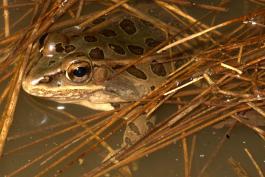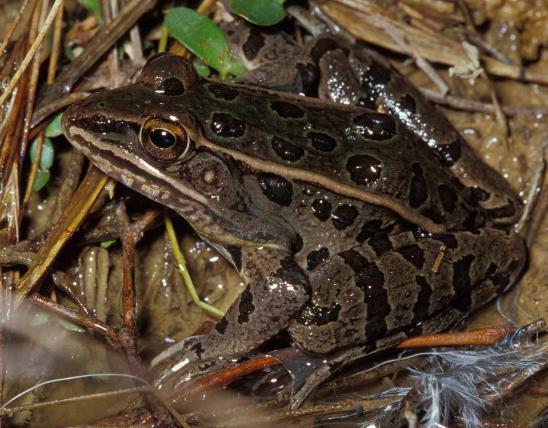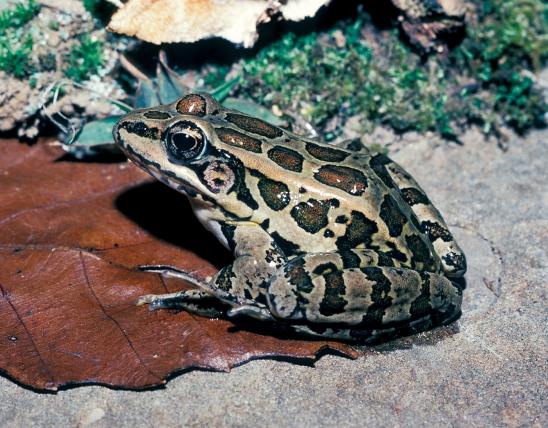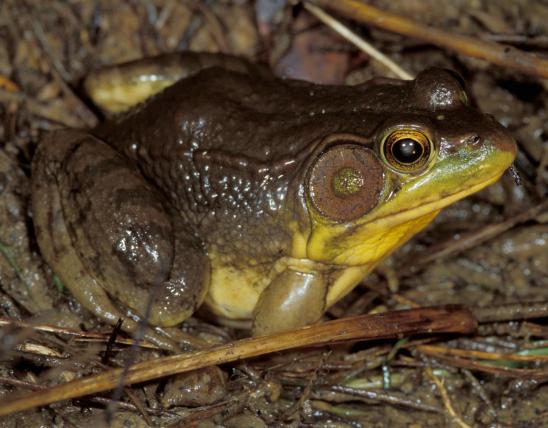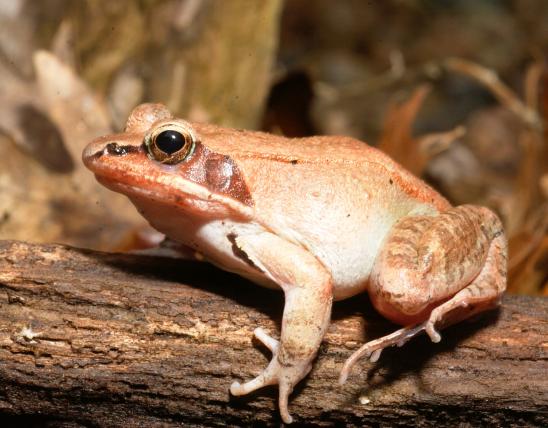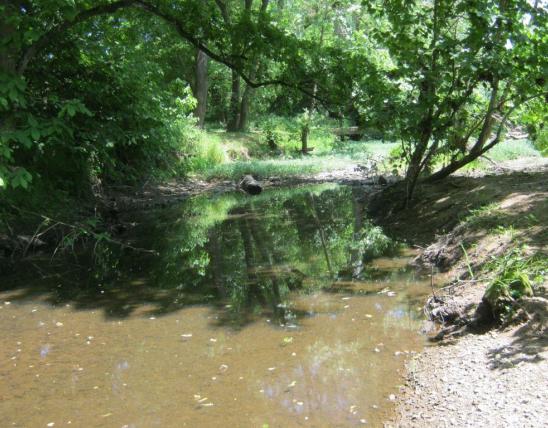
The plains leopard frog is medium-sized, with a light tan ground color and numerous rounded spots on the back. The head is wide and blunt, giving this frog a stocky appearance. There is a distinct light line along the upper jaw. A white spot is almost always present on the tympanum (rounded ear spot). The ridge of skin along each side of the back is broken near the groin, and a small hind section of it is usually shifted upward (toward the midline). The numerous brown or greenish-brown spots on the back and legs are usually circular and uniformly shaped. The snout usually has a dark spot. The belly is white with pale yellow near the groin and lower inner thighs.
The call of male plains leopard frogs is a rapid series of guttural “chuck-chuck-chuck” sounds at a rate of 3 per second.
Similar species: Missouri’s two other leopard frogs and the pickerel frog all lack the distinctively narrow and broken/displaced skin ridges along the sides of the back; also recall that the plains leopard frog lacks distinct white rings around each spot on the back.
In a number of Missouri counties, the plains leopard frog occurs within the same geographic range as the southern leopard frog, and in our northwestern counties, it can occur in the same places as the northern leopard frog. Hybridization with these two species may occur, usually where habitats have been altered due to human activity. When a breeding habitat is changed, the environmental barriers that would normally isolate species during their breeding season are lost, and hybridization may occur. The hybrid offspring usually show a blend of their parent species' characteristics and may be tricky to identify.
Missouri has eight members of the true frog family. These are typically medium to large frogs with long legs, smooth skin, and well-developed webbing between the hind toes. Another common characteristic is a glandular fold or ridge of skin along each side of the back (these are called dorsolateral folds).
Adult length (snout to vent): 2 to 3¾ inches; occasionally to 4½ inches.
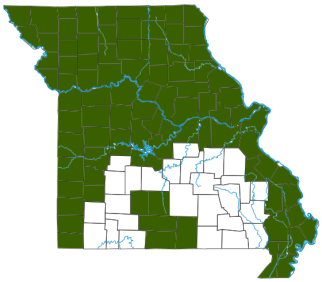
Occurs throughout most of Missouri, including the Bootheel, but rarely present in the Ozarks.
Habitat and Conservation
Active from March to October. Primarily a Great Plains species. In Missouri, the plains leopard frog lives in grasslands, including former prairie regions and associated river floodplains of northern, central, and western Missouri. It also occurs in the sand prairies and river floodplains in the Bootheel. It lives in a variety of aquatic habitats, including water-filled ditches, farm ponds, river sloughs, small streams, temporary pools, and marshes.
During winter, these frogs retreat into the mud and dead leaves at the bottom of ponds and streams.
In summer, individuals mostly live in and around wet areas, but they also venture into grassy areas away from water.
In favorable habitats, this species can be quite abundant, and hundreds have been seen at at time on dirt roadways at night.
Food
The plains leopard frog eats a variety of small invertebrates, including flies, beetles, spiders, worms, crickets, and grasshoppers.
Status
Taxonomy: The true frog family (Ranidae) is the largest and most widespread family of frogs. It contains 365 species in 14 genera and probably originated in Africa. Representatives of this cosmopolitan family occur on every major land mass except New Zealand, Antarctica, most oceanic islands, the West Indies, and southern South America. The largest genus in the family in the New World (North and South America) is Lithobates (formerly Rana), with about 50 species. Missouri’s species, formerly in genus Rana, are all in genus Lithobates. As of taxonomic understandings in 2016, the Rana genus is considered restricted to the eastern hemisphere and western North America. In Missouri, the genus Lithobates is represented by eight species.
Life Cycle
Breeding in Missouri is generally from mid-April to early June (sometimes as early as mid-March); some years they breed in autumn, too, if the weather is cool and rainy enough. Males gather at a marsh, pond, or temporary pool and begin calling after sunset. Females lay eggs in rounded masses that are protected by a thin coating of clear jelly. The clusters are attached to submerged stems or branches in shallow water. Each mass can have 4,000–6,500 eggs, which hatch in 2–3 weeks. Tadpoles become froglets in midsummer (about 3 months after egg laying) or, if they hatch late in the season, may overwinter as tadpoles in the ponds and transform the next spring.
Human Connections
As predators, these amphibians help decrease populations of many insects that are pests to humans. Additionally, their strange, rhythmic calls add to the magic of a Missouri evening.
Missouri’s anglers sometimes use plains leopard frogs as live bait (daily limits apply, however; check current fishing regulations to make sure you’re using them legally).
Ecosystem Connections
Frogs are predators that help keep populations of insects and other small animals in balance.
These frogs, and especially their eggs, tadpoles, and young froglets, become food for both aquatic and terrestrial predators, including ribbonsnakes and gartersnakes.








